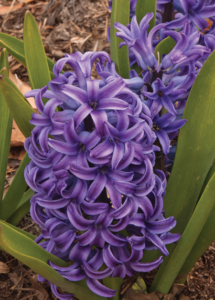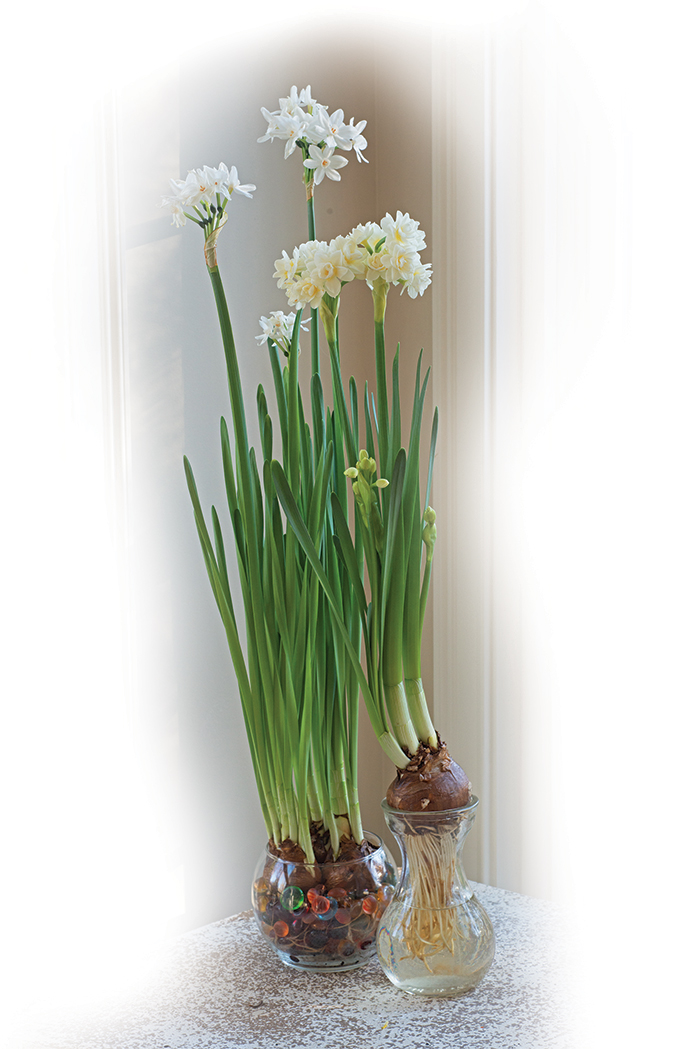With the summer garden becoming a memory, many backyard growers have hung up their hoes and now turn to the comforts of tending indoor plants. But while there are houseplants that will flower during the coldest times of the year, few seem fast to grow and eager to show. One pretty exception is the tazetta daffodil (Narcissus tazetta).
Unlike most other daffodils, tazettas (also known as paperwhites) grow from bulbs that don’t need the extended chill time of winter to stimulate blooming. This makes them excellent candidates for a nifty trick called forced flowering.
Forced flowering simply speeds up a plant’s maturity by simulating outdoor conditions indoors. In the easy-to-please tazetta daffodil’s case, this means tucking planted bulbs away in a cool, dimly lit backroom until young shoots and roots begin to sprout, usually in about two weeks. Then, bring the flowering bulbs-to-be into an area that receives sunlight. Lots of sunlight. I have found tazettas that don’t bask at least five hours in the winter sun tend to be tall floppers and need staking.
Planting these bulbs in potting soil will certainly work, but the fun way to grow tazettas is in water — just so you can watch the roots wake up and wiggle their way to maturity. A clear vase with an opening that will comfortably seat the bottom of a single bulb will work, but for a cluster planting, consider a bowl about three inches deep filled with colorful pebbles.
Bulbs should be set so just their bottom quarters are in water. Maintain this level of contact through the tazettas’ growth period. Since the bulbs have stored up all the energy they are going to need for the flower show to come, adding fertilizer to the water will not be necessary.
With its sun and water requirements met, a tazetta daffodil will bloom in just over a month. The clusters of small, white to light cream blossoms will then beautifully linger for a week or even longer. If you like their looks, consider staggering plantings to have fresh indoor flowers through the cold, dreary winter months.
Descriptions online and in books often mention these pretty blossoms are fragrant, and they are, but to me, many of them smell off-sweet, bordering on industrial. My best comparison is the scent of carpet glue. Honest.
Tazetta bulbs can be easily spotted in garden stores at this time of year, with the thinking being they make nice Christmas gifts whether in bloom or still in the box. Some of the standard varieties to be found include ‘Ziva’, ‘Galilee’ and ‘Jerusalem’.
In December
When your Christmas cactus pops into bloom, place it in a bright, naturally lit room and reduce watering to prolong the flowering period.
You will be wrapping lots of Christmas presents this holiday season, right? Cut those wrapping paper tubes into 4-inch-long pieces so they can be used as collars around newly planted annuals next spring to protect them from cutworms.
If you have any gasoline left in motorized garden equipment, remove it before tucking such handy machinery away for the winter. Over months, gas can lose some of its “fizz” and gunk up carburetors.

Hyacinth
Now is the prime time to plant spring-blooming bulbs. Daffodils, hyacinths (Hyacinth orientalis), Spanish bluebells (Hyacinthoides hispanica), squills (Scilla sp.), snowdrops (Galanthus sp.), summer snowflakes (Leucojum aestivum), grape hyacinths (Muscari armeniacum), alliums (Allium sp.) and fritillaries (Fritillaria sp.) are all eye-catching variets with off-putting flavor to would-be garden raiders like deer, voles and squirrels.
Hollyhocks looked raggedy this year? Chances are good they could have been afflicted with a disease called rust. To help prevent this blight next summer, cut off the old stems — where rust likes to overwinter — and discard them. Do not compost.
- Celebrate Fuquay Festival
- Have a Hometown Holiday
- Reflect on the Season
- Have a Holiday Happy Hour
- Don We Now Our Party-Perfect Style
- Shop for a Cause
- Decorate Cookies like a Pro
- Wrap the Prettiest Packages
- March in a Parade
- Holiday Gift Guide 2019
- In 2020, I want to… Become A Ninja Warrior
- Harvest Moon Bakery-Cafe
- Southern Supreme Fruitcake & More
- Early Spring: Forcing Tazetta Daffodils
- North Carolina Holiday Spirits
- June and Keith Propes & Tim Congleton
- FVM’s New Years Resolutions







